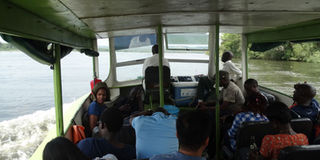It’s wild, beautiful in Murchison Falls NP

Jounalists take part in a boat ride on the Nile en route to the Murchison Falls. PHOTO BY C. OTSWAMMAH.
What you need to know:
MURCHISON FALLS. It felt like a new world after a game drive, sailing the Nile and hiking the waterfalls, writes C. OTSWAMMAH.
It is always refreshing to visit Murchison Falls National Park, the largest protected area in Uganda measuring 3,893 square kilometres (1,503 sq miles). It was gazetted a national park in 1952.
My latest sojourn to the park was in June as part of a group of journalists on a guided tour by Uganda Tourist Board (UTB) which, beyond marketing the country abroad, has embarked on the arduous task of popularising domestic tourism. This tour was aimed at showing the media the immense beauty of Uganda’s wild so this can in turn be shared with the public.
Unlike the previous time when I entered the park through the southern sector’s Kichumbamayo Gate right into the expansive Budongo Forest, this time we used the Chobe Gate after the Karuma Bridge. It would be an experience like no other. In the forested southern sector, one will drive through miles upon miles of forest and woodland without sighting any wild animals beyond the baboons or the occasional antelope. Not so in the northern sector.
We arrived at the Chobe Gate around 5pm and the 15km-drive from the main gate to Chobe Safari Lodge revealed half a dozen elephants, a number of giraffes, several warthogs and – unbelievably – hippopotamus. It was a good introduction to what awaited us the next day.
We got an early treat though. In the evening as we sat around a campfire sipping the frothy stuff, and washing down the pieces of goat and chicken mchomo, a huge hippo ambled towards us from the river below. It is a massive animal weighing up to five tonnes! It kills for pleasure and security. Both were possibilities here. Thank God the ranger/guard who had been keeping watch all the while knew what to do. He shone a bright light right into its eyes, making the massive animal change course and eventually return to the water. He sure has done this many times. We were most relieved, but also quite excited.
Riding to the Tangi Gate
Come morning, the rising sun found us on the Karuma-Arua highway heading to Tangi Gate which is at the northern most part of the park near Pakwach. The ride was rather boring and uneventful until we neared the Tangi Gate and behold, a herd of elephants where browsing by the roadside completely oblivious of the traffic. The jumbos are massive and beautiful. They remained unbothered as we snapped photographs for close to 10 minutes.
Now into the park, the northern sector is animal and vegetation rich. Driving through the park, we saw many animals at close range – elephants, giraffes, hartebeest, waterbucks, impala, to mention a few – and many birds. Being in the midst of this state of nature, I could not help thinking how beautiful it all was a thousand years ago!
Arduous climb
In the afternoon, we sailed along the Nile to the bottom of the powerful Murchison Falls where the boat left us so we could climb to the top of the falls where the bus was waiting. It was tough. I almost collapsed midway and considered going back. But there was no boat.
When I finally made it to the top (among the last batch of the group), the view was spectacular as I saw the big river squeezed into seven or so metres to produce a thunderous water fall below.
My last word: make time to visit Murchison Falls National Park. No experience is similar.
Setting off for adventure
The rising sun found us on the Karuma-Arua road heading to Tangi Gate which is at the northern most part of the park near Pakwach. The ride was rather boring and uneventful until we neared the Tangi Gate and behold, a herd of elephants were browsing by the roadside oblivious of the traffic. The jumbos are massive and beautiful. They remained unbothered as we snapped photographs for close to 10 minutes.




